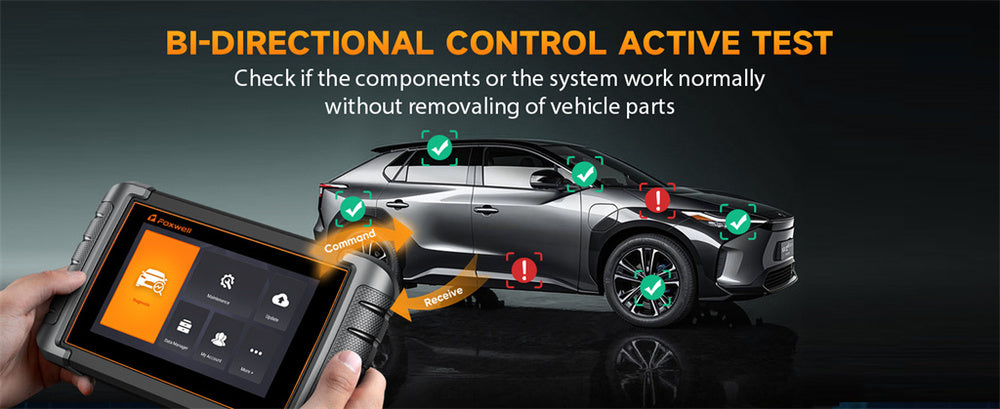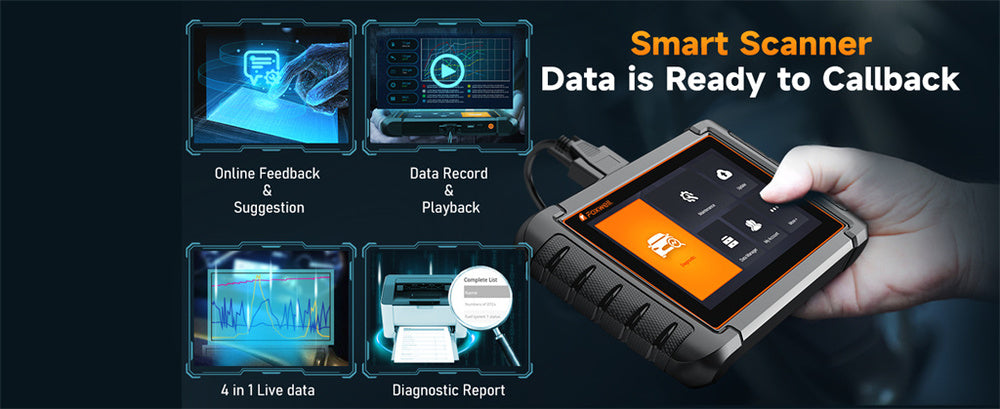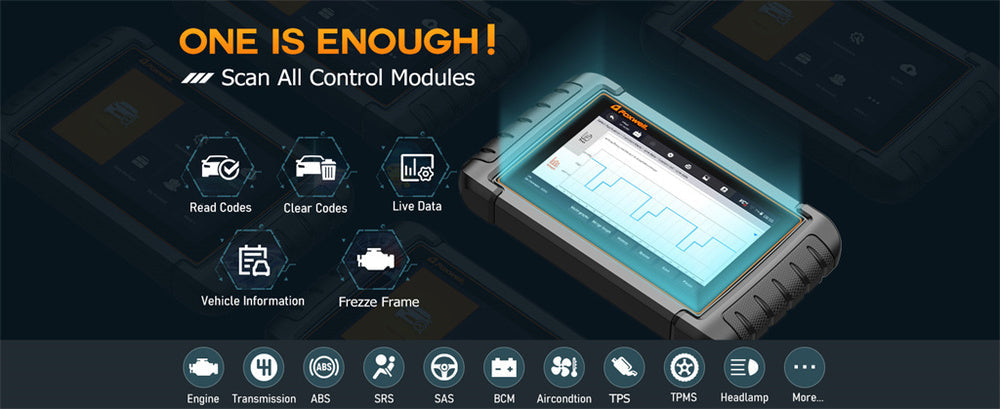Uning OBD2 codes with a scanner is an indispensable skill for keeping vehicles healthy and diagnosing potential issues. When the "Check Engine" light illuminates, this often indicates that their onboard diagnostic system has detected something amiss with their Vehicle.
An OBD2 scanner makes it possible to access and interpret trouble codes stored in a vehicle's computer, understand what might be amiss, and clear these codes once issues have been addressed.
Connecting an OBD2 port, typically found beneath the dashboard, to a scanner, reading codes from OBD2, and using its clear function to erase them are typical steps in the OBD2 scan process.
Different scanner models offer various levels of functionality - basic models to professional-grade devices can all perform this step successfully.

What Are OBD2 Codes?
Onboard Diagnostics II (OBD2) is a standardized system implemented in vehicles to perform self-diagnostic and reporting capabilities. When an issue arises within your car's system, OBD2 stores a code that illuminates its Check Engine light to alert you.
OBD2 Code Types
There are two broad categories of OBD2 codes: generic and manufacturer-specific. Generic OBD2 codes with the "P0" prefix apply to all vehicles, while "P1" indicates manufacturer specificity for specific brands or models.
Common Causes of OBD2 Codes
Many causes can trigger OBD2 codes, including defective sensors, loose gas caps, or nonfunctioning catalytic converters. These issues may range from minor inconveniences to major mechanical complications and should always be taken seriously by motorists.
Why Clear OBD2 Codes?
Clearing OBD2 codes is beneficial in many ways, including improving vehicle health and improving driving experiences. Furthermore, clearing temporary issues quickly can save money on repairs over time.
Some OBD2 codes that occur temporarily, like a loose gas cap or sensor glitch, can be temporarily eliminated by clearing all codes at once. This will help reset the system and eliminate temporary warnings so your Vehicle can recalculate correctly.
Diagnosing Intermittent Problems: Clearing OBD2 codes effectively diagnose intermittent issues by creating an "open slate." If a problem recurs after clearing, this indicates a more serious underlying issue that needs further attention.
Passing Emissions Tests: Many regions require vehicles to pass emissions tests. A glowing "Check Engine" light, caused by OBD2 codes, can automatically fail the test; clearing these codes once resolved ensures a clean bill of health when emissions testing takes place.
Improving Vehicle performance: OBD2 codes can seriously compromise vehicle performance, mainly if they involve critical components like oxygen sensors or catalytic converters. Once resolved, clearing OBD2 codes can improve engine efficiency, power output, and responsiveness - an added boost for performance!
Increase Fuel Efficiency: OBD2 codes may indicate issues compromising fuel efficiency, such as inefficient combustion or defective sensors. Once these issues have been rectified, clearing these codes helps restore optimal consumption - saving money at the pump!
Enhancing Vehicle Longevity: Addressing and clearing OBD2 codes helps reduce long-term damage to vehicle components, increasing their lifespan while decreasing future repair costs. Taking these proactive measures extends vehicle lifespan while mitigating costly repairs later down the line.
Avoid False Alerts: OBD2 codes may be activated by issues that have already been resolved, triggering false alarms and creating unnecessary warnings for drivers. By clearing these codes away, unnecessary notifications can be eliminated so you can focus on solving actual vehicle-related problems more effectively.
Before Beginning a Road Trip Prior to embarking on any long trip, it's advisable to clear OBD2 codes to ensure the Vehicle is operating at peak performance and prevent breakdowns and issues during your journey. This will give both driver and passengers peace of mind during their travels.
Resetting After Repairs:Once repairs or maintenance have been performed on a vehicle, clearing OBD2 codes is an invaluable way to reset its system to accurately reflect its current state. This practice helps ensure repairs are successful and no further issues exist.
Peace of Mind: A check engine light can be stressful and distracting. Clearing OBD2 codes after solving the issue gives drivers peace of mind so they can drive without worrying about potential vehicle problems.
Starting Right Here
Selecting an OBD2 Scanner
Finding the appropriate OBD2 scanner depends on your needs and budget. Basic models offer simple reading/clearing functionality, while more advanced models offer features like live data feeds or compatibility with multiple vehicle brands. Foxwell scanners are an excellent balance of user-friendliness and functionality, with various models tailored towards newcomers and experienced professionals.
Preparing Your Vehicle
Before connecting a scanner, ensure the Vehicle is parked and turned off. In addition, check its manual for any specific instructions or precautions, and collect all relevant information, including its VIN, make, and model number, to streamline the scanning process.
Locating and Connecting an OBD2 Scanner
Locate the OBD2 port under the dashboard and connect your Foxwell scanner. Thanks to their intuitive user interfaces and robust connectors, the process should be straightforward. Once connected, turn on your Vehicle without starting its engine so the scanner can initiate communication with it.
Foxwell Scanners Are Renowned for Efficient OBD2 Code Clearance Foxwell.
scanners are well known for their user-friendly design and efficiency, making them the go-to choice when clearing OBD2 codes with ease.
To do this with one, follow these steps.
Plug in the Scanner: Connect your Foxwell scanner to the OBD2 port under your dashboard - this port is generally near the driver's side for easy access. Its Turn On Vehicle: When turning on the ignition without starting the engine, your Foxwell scanner should display its menu.
Use the arrow keys to navigate and select "Diagnostic" on the menu; this feature allows you to identify and clear codes.
Choose Vehicle Make: Foxwell scanners support a wide variety of car models when selecting vehicle models from the drop-down list, so this step is essential for an accurate diagnosis.
Read OBD2 Codes:Once you've chosen your Vehicle, choose "Read Codes" to access its OBD2 codes and their descriptions. Your scanner will show a list of codes alongside their descriptions.
Clear Codes: Once you have reviewed the codes, select and confirm "Clear Codes" to remove them from the system. Your Foxwell scanner may prompt for confirmation before clearing them away.
Restart Your Vehicle: Once clearing codes are achieved, restart the Vehicle to verify they were successfully removed. Foxwell scanner's intuitive user interface enables even novice users to navigate and clear codes effortlessly.
Clearing the Codes
Manual or Automatic Clearing: Some OBD2 scanners allow manual clearing while others automatically reset codes; manual clearing gives more control, whereas automatic clearing can quickly reset codes.
Basic Scanners Offer Clear Code Reset Button: Basic scanners usually feature an "Erase" or "Clear" button to quickly reset codes after reading them; press it after reading each code to remove them from your system and clear away from its memory.
Clearing Codes with an Advanced Scanner: Advanced scanners offer more in-depth options for clearing codes, including resetting specific systems or performing diagnostics before clearing. These tools are perfect for conducting comprehensive vehicle assessments.
After clearing codes, taking your Vehicle on a test drive is advisable to confirm if the issue was addressed or resurfaced, indicating an ongoing problem. This will allow you to ascertain if any codes reappear, indicating a persistent issue that requires more work to resolve.
Troubleshooting
What If Codes Reappear? If codes reappear after being addressed, this indicates an ongoing issue. Re-scan your Vehicle to identify the persistent problems; seek professional assistance if you are unsure of a solution to fix them.
Common Mistakes When Clearing Codes
Common errors when clearing codes include:
- Not addressing their source.
- Using incompatible scanners.
- Disregarding manufacturer-specific codes - errors that could lead to ongoing problems and misdiagnoses.
When To Consult Professional Help
Seek professional assistance if the codes you're dealing with are complex, involve critical systems, or lack the tools and expertise for accurate diagnosis and repair.
Safety Precautions: Always practice appropriate safety procedures when handling electrical systems or components, such as using insulated tools, avoiding distractions, and wearing protective gear.
Regular Maintenance Helps Prevent OBD2 Issues Routine: vehicle maintenance—such as oil changes, filter replacements, and system checks—helps avoid OBD2 problems by keeping the Vehicle running at peak performance.
High-quality: high-grade fuel can significantly decrease engine issues and carbon build-up, leading to fewer OBD2 alerts and more extended vehicle health.
Monitoring Dashboard Indicators
Paying close attention to dashboard indicators and responding promptly can prevent minor issues from turning into bigger ones that require OBD2 diagnostics.
Utilizing Professional Diagnostic Services Professional diagnostic services provide an essential way of detecting potential issues before they activate OBD2 codes, protecting long-term vehicle health.
Benefits of Clearing Codes
Enhance Vehicle Performance
Clearing OBD2 codes can improve vehicle performance by addressing engine efficiency, power output, and responsiveness issues that affect engine output.
Fuel Efficiency OBD2 Code Clearance can increase fuel efficiency and lower emissions by addressing issues like defective oxygen sensors or ineffective combustion, thus improving fuel economy and decreasing emissions.
Regular Diagnosis and Clearance of OBD2 Codes to Prolong Vehicle Lifespan
Routine diagnosis and clearance of OBD2 codes help avoid long-term damage, prolonging vehicle lifespan while decreasing costly repair expenses.

Conclusion
Learning how to clear OBD2 codes with a scanner is an invaluable skill for any vehicle owner or automotive enthusiast, providing the means for early identification of minor issues before they escalate into larger ones, optimizing vehicle performance, and passing emissions tests with minimal equipment and effort required. Regularly diagnosing and clearing OBD2 codes can prolong vehicle lifespan, improve fuel economy, and have peace of mind knowing your car is in tip-top condition. So, how often should OBD2 codes be cleared?
Clean OBD2 codes as needed after solving an issue or prepping for inspection. Avoid unnecessary frequent clearing.
FAQs
Can clearing OBD2 codes cause issues?
Inadvertently clearing OBD2 codes without first solving their root cause may result in repeated issues; however, generally, this doesn't compromise vehicle health.
Are all scanners capable of clearing OBD2 codes?
No, not necessarily; some basic models may only offer limited functionality, while advanced scanners provide comprehensive diagnostics and clearing features.
Do all scanners clear OBD2 codes?
Not all scanners clear OBD2 codes. Basic models might have limited functionality, while advanced scanners offer comprehensive diagnostics and clearing options.




Leave a comment
This site is protected by hCaptcha and the hCaptcha Privacy Policy and Terms of Service apply.